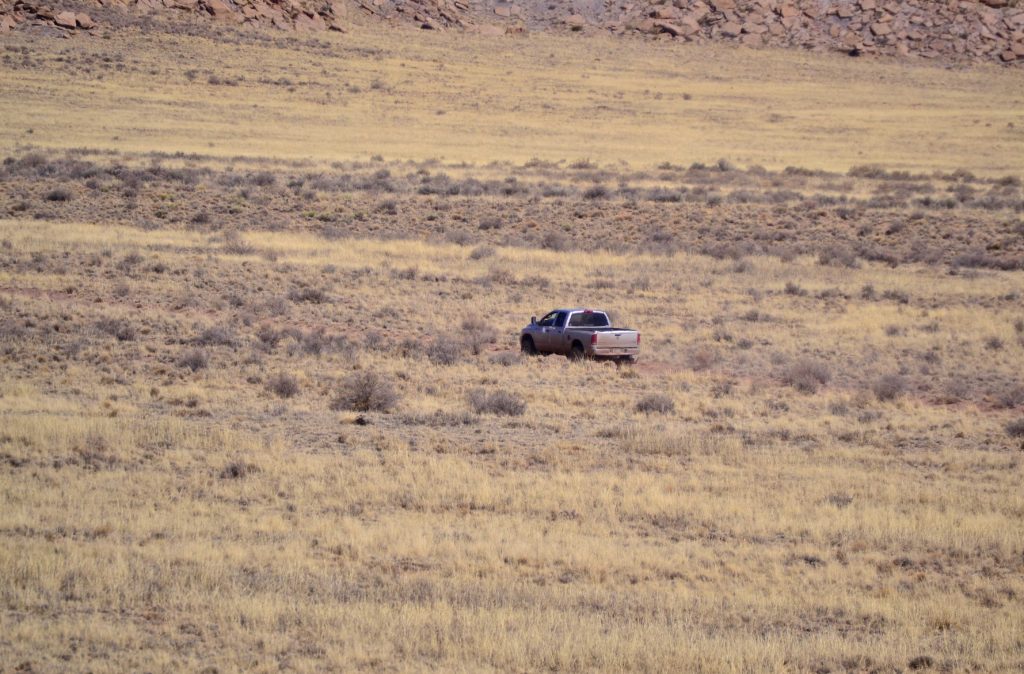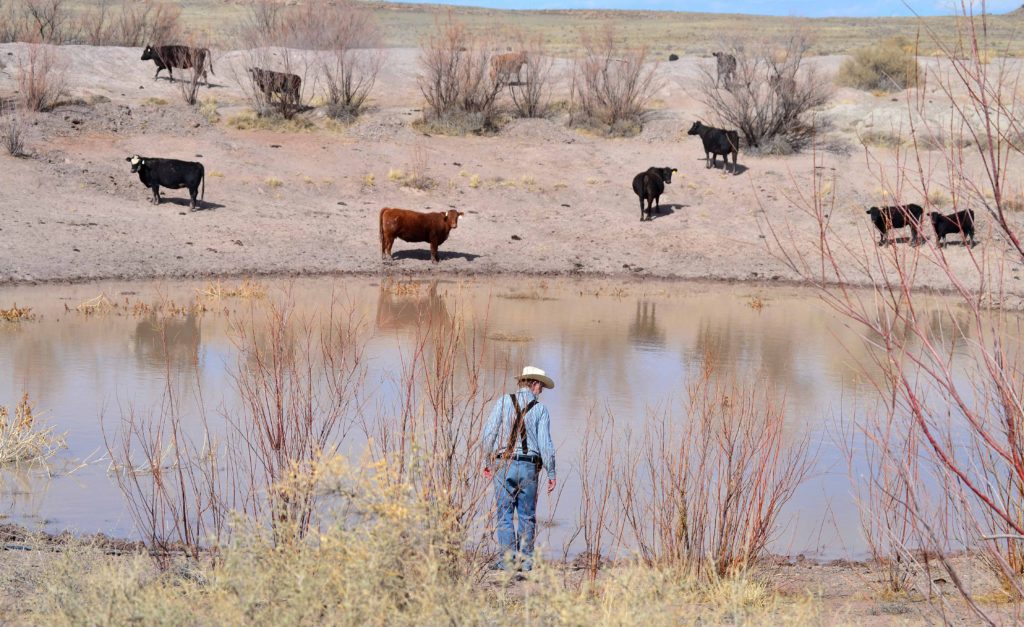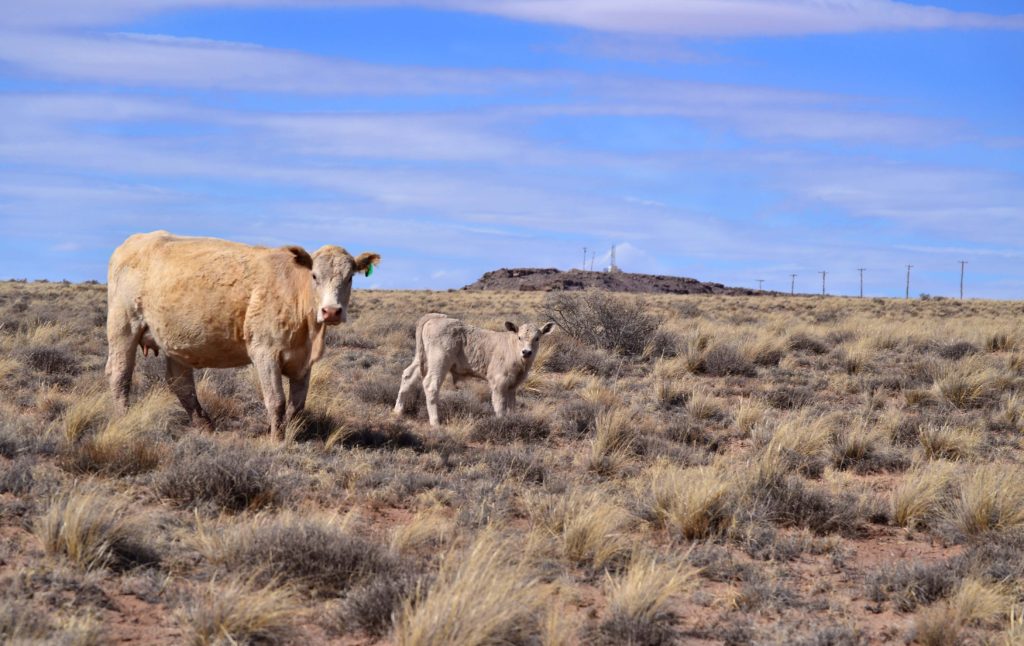Cattle ranching is a big subject! And it’s one that’s very near and dear to my heart, as I’ve spent most of my life in the business one way or another.
Twin Buttes Ranch (TBR) has been used as both a sheep ranch and a cattle ranch, over the years, since about 1869 to the present. It has also been used to temporarily run large numbers of horses, although it is far more sustainable to simply maintain a few riding/working horses.
I know the beef or cattle business, for which I believe TBR is most suited.
Why TBR is a Cattle Ranch
Northeastern Arizona lies on the Colorado Plateau. Many have called it a desert – which it can resemble in periods of drought – but the country is, in fact, very different from any desert.
This is high country, some 5,800 feet in elevation, and it naturally grows dryland or short grass. Given enough rain and proper management the grass or “natural feed” would hold its nutritional value to maintain the health of the livestock.
Under ideal circumstances this makes for perfect cow/calf ranching – where the yearlings to sell for feed would be taken either to mountain pasture or a feed lot prior to selling. In the past TBR was always able to sustain or carry a sufficient number of livestock year round to make a ranching operation profitable.
Twin Buttes Cattle Ranch in Arizona
There is of course no set number that the land can carry. A general estimate is roughly 6 to 10 cow/calf pairs per one section of land, assuming that smaller British breeds would be stocked.
TBR could easily carry 600 pairs year round under normal rainfall amounts as it is good country with plenty of grass.
TBR became a cattle ranch after several attempts to run sheep through it during the Old West.
There are still buildings and infrastructure from the sheep men, but they eventually found that this country doesn’t hold sheep well.
This is because sheep have softer mouths than cattle, and they can’t bite off the short, coarse grass that’s native to the Colorado Plateau. Instead sheep will grab hold of the grass and pull it up by the roots – which in country with shallow, light topsoil means that the entire root system comes up.
So sheep leave bald patches, and can eventually ruin country.
Horses were also tried in various holding pastures, but horses in large numbers are much rougher on country than cattle. Partly this is because they require more and richer feed. And also partly because they don’t have cloven hooves, and therefore in the type of soil in the Colorado Plateau they tend to tromp the grass down and ruin it in large numbers.
A pretty good rule is that a horse needs quite a bit more country than a cow and calf pair, and so they aren’t as feasible in large numbers.
The Challenges of Ranching on the Colorado Plateau
While under normal circumstances TBR and much of the rest of the Colorado Plateau is beautiful cattle country, there are some natural hardships to consider.
Specifically rain is absolutely necessary to sustain any livestock operation.
I could go on for days about the history of rainfall, the natural climate of the arid Southwest, proper land management, water conservation, and infrastructure.
Suffice it to say, however, that during periods of limited rainfall, ranching can become hard to impossible on the Colorado Plateau. This is why I always felt that a rancher should have something else of value on his land – although this dream was never realized for me.
In general my family has always tried to understock the land to preserve grass and water resources for the hard years.
Sadly, the Colorado Plateau – and indeed most of the West and Southwest – has been experiencing extreme drought for the past 30 years. Most people are only acquainted with the hardships of the last few years, when the water in Lake Mead began to run low, but ranchers and farmers will tell you that rain has been scarce for far longer.
Existing Infrastructure
TBR is also a very undeveloped ranches with only one partition fence dividing 60 sections into two pastures, the north pasture only about a third of the size of the south one.
The reason for this is that it was always a leased ranch from the time that the railroad was completed about in 1882. The railroad was given a very large tract of land from the government to cover their expense of building the improvement for the nation at the time.
These lands were then put in the hands of institutions to oversee them. New Mexico and Arizona Land and Cattle Co. and the Aztec Land and Cattle Co. were the two in our area.
Obviously, a rancher who did not own the land would not venture as much capital into improvements of a property as one who owns the land would.
Myself and my family were the first private owners ever to hold the land, and as we were a single family operation, this put us under quit a financial strain, first in acquiring the land and then in working it.
When I took control of the existing Twin Buttes Ranch (separate from the larger ranch that was one entity under my parents) in January of 1986 the first of the drought was already underway. I was only able to build about 10 miles of fence from that time until now.
Rather than bore you with details of my methods and ideas of ranching, I’ll leave you with the thought that cattle ranching that does not involve farming.
Instead it’s an operation that requires the creativity of an individual to figure out what works in the countless details that make up the daily life of a rancher. It’s very good to be able to do your own thing but, the reality is you can’t really blame someone else for your mistakes.
Free will and accountability go hand in hand when taking care of a bunch of cattle. (And such is the cowboy’s philosophy developed from spending a lot of time alone with the land.)
Basically, from the view point of any rancher, the place could use a lot more in the way of fencing and water development.
From the viewpoint of a mining or renewable energy investor, however, the lack of general infrastructure may prove to be quite a boon. Although some roads will have to be built, there aren’t any fences or corrals to take down – and the existing water reservoir dirt tanks are easy to work around.
Hope for the Future of TBR
In the last two years – especially the winter of 2018-19 – has seen normal rainfall again.
We all remain hopeful that the recent drought is over and that we will never again have to endure such a hardship. The moisture we are receiving now seems to indicate that this is the case.
However, from the viewpoint of a man who has reached 68 years, I can tell you that my dream for the land has changed.
While at one point I wanted to see it as a large cattle spread in the tradition of the great Texas and Montana ranches where a family could be raised close to the earth, I have come to see that these days may be over.
I would never want to see a young man or his family try to break his back and his heart (the way I did) alone on country that can be rough in the best of years.

Instead it is my dream is to see TBR go to someone who will not only love the land, but realize some of the great potential this forgotten land has for being productive.
Someday in the future I would love to be able to drive down old Highway 180, and the vast landscapes being sustained by only an acre or two of surface used for mining the shallow potash deposits.
Or to see cattle grazing underneath wind turbines, or around a solar farm.
I would even love to see archeologists able to excavate some of the Anasazi ruins and bring the history of the ranch to world, while the owner of the land can enjoy recreation such as four-wheeling, riding, or hunting.
While in most places an investor would have to settle for just one
Because of the vastness of TBR, and the spread of these resources – coupled with amazing new technology innovations in mining and energy – much of the natural beauty could still be enjoyed while turning TBR into a very profitable operation on a number of levels.
If that person could be you – please contact us. He’d love to tell you all these details and more, and maybe even schedule a guided tour.


